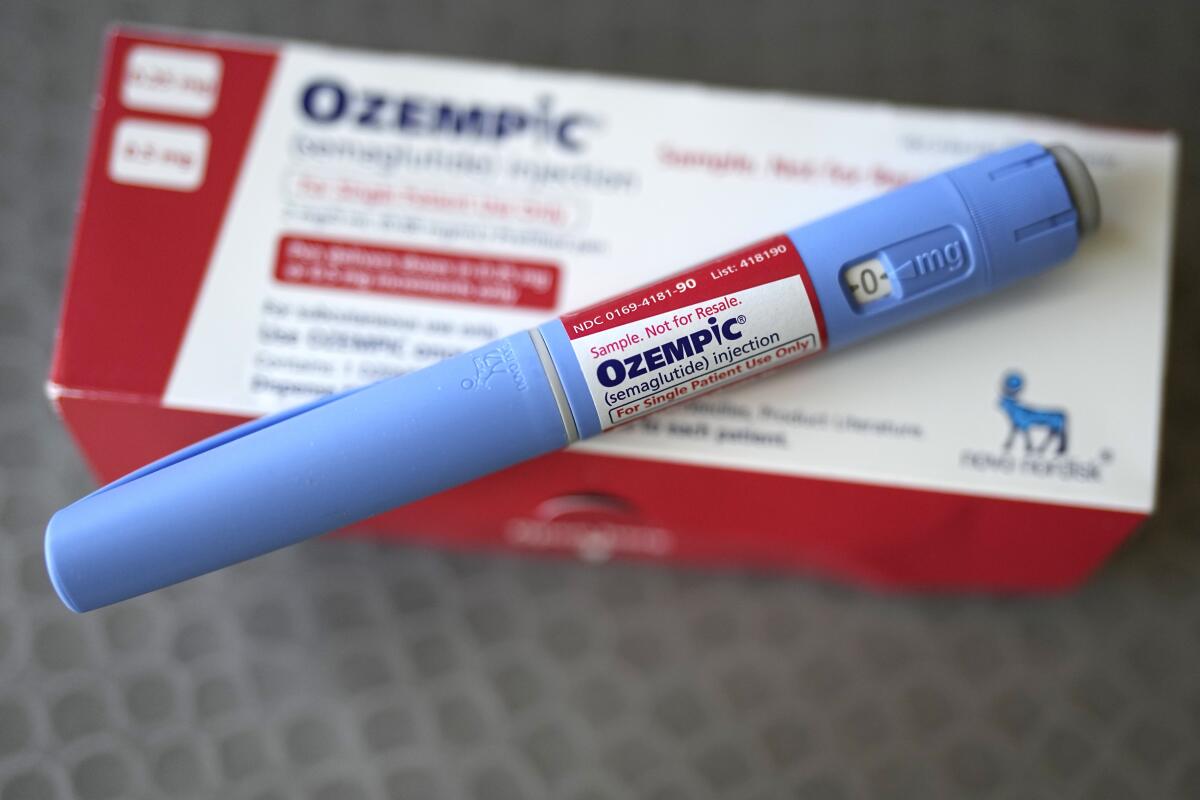Ozempic overdose? Poison control experts explain why thousands OD’d this year

- Share via
Some of those taking Ozempic or Wegovy are learning that too much of a good thing is never good.
Semaglutide, the medication prescribed under the brand names Ozempic, for treating Type 2 diabetes, and Wegovy, for weight management, works by mimicking the hormone GLP-1, which is released by the gut after eating. The hormone has several effects in the body, such as stimulating insulin production, slowing gastric emptying and lowering blood sugar.
It has been hailed for its weight-loss benefits, most conspicuously among celebrities. Oprah Winfrey recently said she uses weight-loss medication and lauded “the fact that there’s a medically approved prescription for managing weight and staying healthier, in my lifetime.” She said it felt “like a gift.”
But between Jan. 1 and Nov. 30 this year, at least 2,941 Americans reported overdose exposures to semaglutide, according to a recent report from America’s Poison Centers, a national nonprofit representing 55 poison centers in the United States.
California accounted for about 350 of the reports, or around 12%, according to Raymond Ho, the managing director of the California Poison Control System. Ho said the number roughly corresponds to the proportion of California’s population to the rest of the country.
The nationwide number of semaglutide overdoses this year is more than double the 1,447 reported in 2022, which was more than double the 607 semaglutide overdoses reported in 2021.
There were only 364 reported semaglutide overdoses in 2020 and 196 in 2019, less than 10% of the number that occurred so far this year.
America’s Poison Centers released the data with a disclaimer that the figures likely represent an undercount in the number of cases involving semaglutide, as the center only included those voluntarily reported to poison control centers.
“It is an alarming trend from a poison center perspective,” Ho said. “We get the usual dosing error calls, and all of a sudden there’s an explosion of people calling much more regularly about this.”
The use of semaglutide and other GLP-1 imitators has surged in popularity over the last year as a quick and effective way to manage weight loss. More than 4 million prescriptions for semaglutide were issued in the United States in 2020, according to federal data, and usage of the drug has continued to grow since then.
Dr. Stephen Petrou, an emergency medicine physician and toxicology fellow with California Poison Control, said there were multiple factors contributing to the increase in overdoses.
“Not only is there rising social popularity” of the drug, Petrou said, “but there’s also wider FDA indications for use.”
Semaglutide was patented by the Danish pharmaceutical company Novo Nordisk in 2012 and has been available in the United States since the FDA approved it in 2017. The drug was originally released as Ozempic for Type 2 diabetics to manage blood sugar levels. Moderate weight loss was found to be a common side effect of the drug, and the FDA approved a different formulation of semaglutide, called Wegovy, for that purpose in 2021.
Ho and Petrou said the different formulations of semaglutide could help explain why it has led to so many more overdoses than other drugs of its class. Both are administered via weekly injections, with Wegovy in single-use pens and Ozempic in needles that can vary in dosage. Standard dosages range from 0.25 mg to 2.4 mg for weekly injections, depending on the prescription.
“Someone who is unable to get Wegovy can resort to using Ozempic instead, because it is the same medication, but they may start to [adjust] their dose” upward, Petrou said. “That’s when they might encounter problems.”
Ho and Petrou said the vast majority of semaglutide overdose reports are accidental, either due to patients not waiting a week between doses or by misunderstanding dosing instructions. Unlike the GLP-1 hormone, which is rapidly metabolized by the body, semaglutide and similar medications have much longer half-lives, meaning the medication can build up inside the body if not enough time elapses between doses.
Furthermore, semaglutide can also be taken orally as a daily pill — sold under the name Rybelsus — but overdoses are rarely reported.
“We’re not seeing cases of mis-administration or toxicity or overdose with that medication,” Petrou said.
Ho and Petrou explained the signs of semaglutide overdose can resemble those of hypoglycemia, also known as low blood sugar. Symptoms can begin with increased heart rate, sweating, dizziness and irritability. More serious cases can cause confusion, delirium and coma.
“If they have hypoglycemia, the good majority of them will have to be admitted to the hospital and monitored and watched closely, because of how long these drugs last,” Ho said.
Ho encourages everyone who is prescribed semaglutide to thoroughly read the medication’s label and follow the dosing instructions listed.
“We always say this: The dose makes the poison,” Ho said.
Anyone who needs emergency poison assistance or has other poisoning-related inquiries can call the national Poison Helpline at (800) 222-1222 or visit the Poison Help website.







